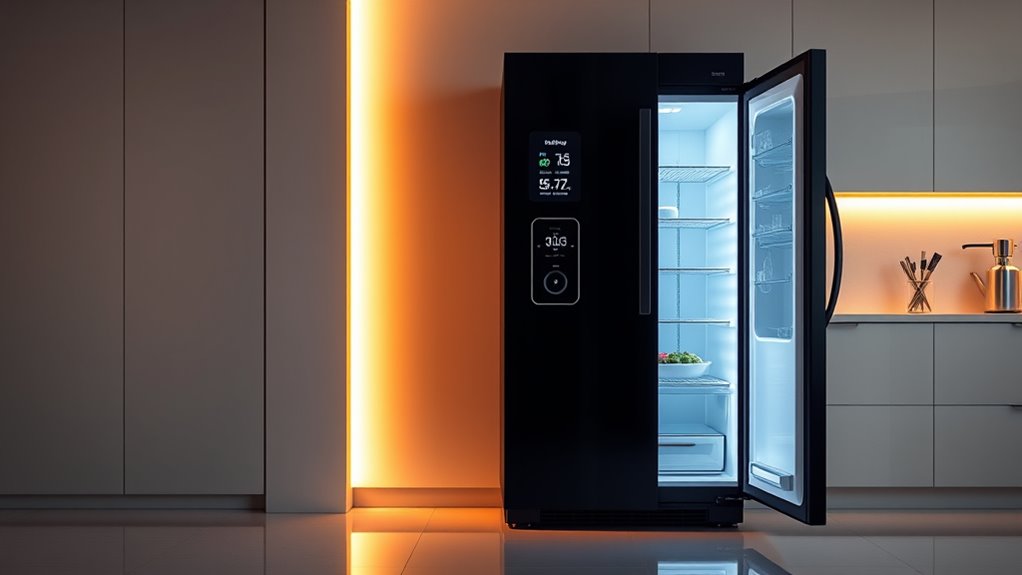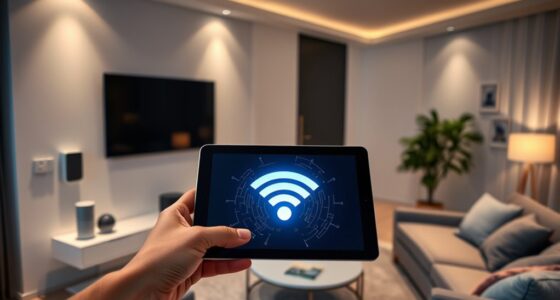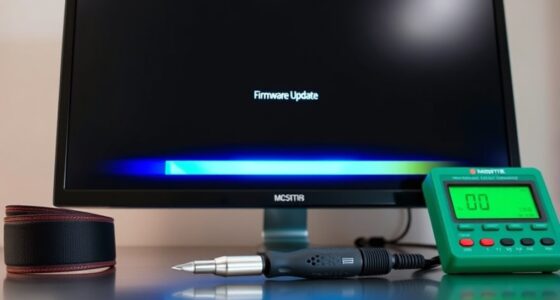Your smart fridge collects data on your habits, preferences, and inventory, often sharing this information with manufacturers or third parties. If the device has weak security, outdated software, or unsecured networks, hackers could access sensitive details or even control your appliance. This raises privacy risks, especially if personal conversations or schedules are exposed. Want to discover how to protect yourself and what hidden vulnerabilities might exist? Keep exploring to learn more.
Key Takeaways
- Smart fridges collect data on your habits, preferences, and inventory, raising privacy concerns about potential surveillance.
- Weak security features like default passwords and outdated software make these devices vulnerable to hacking.
- Data transmitted by smart fridges may be unencrypted, allowing malicious actors to intercept sensitive information.
- Sharing personal data with manufacturers or third parties can lead to targeted advertising and privacy breaches.
- Regular updates, strong passwords, and cautious use of voice commands help mitigate hidden spying risks.
How Connected Appliances Collect and Share Data
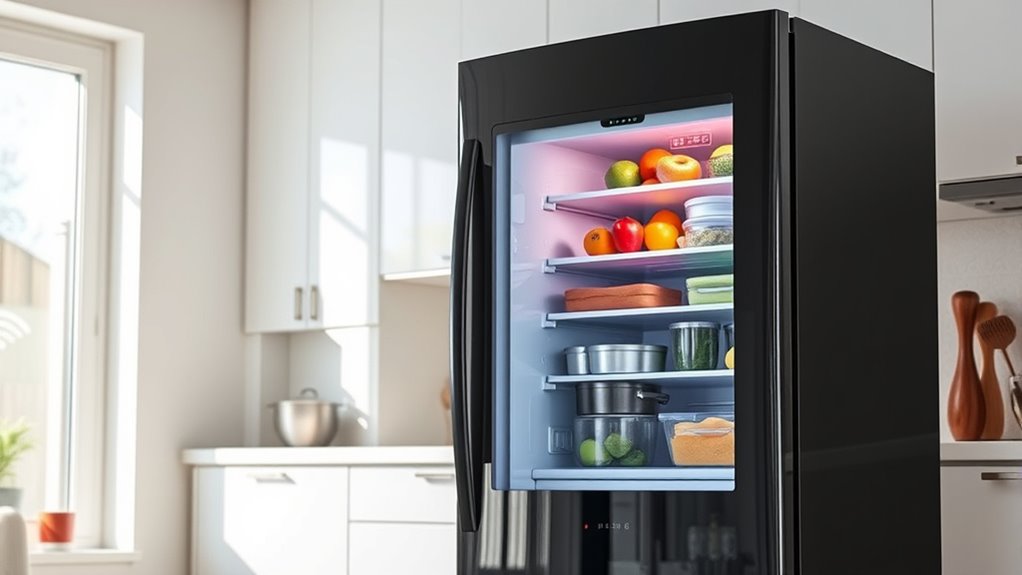
Connected appliances gather data continuously to improve their functionality and user experience. When you use a smart fridge, it tracks your habits, preferences, and even inventory levels. To protect your privacy, manufacturers often implement data encryption, ensuring that your information remains secure during transmission and storage. However, before your device collects any data, it typically requires your user consent, often through privacy policies or prompts. By agreeing, you allow the appliance to share your information with manufacturers or third parties, sometimes for targeted ads or product improvements. While these features can enhance convenience, they also raise concerns about how much personal data is shared and how securely it’s handled. Always review the privacy settings and understand what you’re consenting to when setting up your connected devices. Additionally, developing an understanding of creative practice can help users become more aware of the importance of intentional and secure data handling in their digital routines.
Common Security Vulnerabilities in Smart Devices

Many smart devices, including smart fridges, often have security gaps that hackers can exploit. One common vulnerability is weak or default passwords, which make unauthorized access easy. Voice recognition features, while convenient, can be targeted if not properly secured, allowing hackers to eavesdrop or manipulate commands. Outdated device software also pose risks; failure to regularly install updates leaves known security flaws unpatched, leaving your device vulnerable. Additionally, insecure network connections can expose your smart fridge to cyberattacks, especially if encryption isn’t enforced. These vulnerabilities highlight the importance of changing default passwords, enabling automatic device updates, and ensuring your home network is secure. Staying proactive helps protect your privacy and keeps your connected appliances safe from malicious threats. Digital literacy is also essential for understanding how to identify and mitigate these risks effectively.
Real-Life Incidents Involving Privacy Breaches

Despite the convenience of smart fridges, several incidents have revealed serious privacy breaches. In one case, hackers exploited a vulnerability in a brand’s smart appliance privacy settings, gaining access to personal grocery lists and family schedules. In another incident, weak data encryption allowed cybercriminals to intercept unprotected data transmitted between the device and cloud servers, exposing user habits. These breaches highlight how vulnerable connected appliances can be if manufacturers neglect proper security measures. Even basic lapses, like insufficient data encryption, put your personal information at risk. As a result, your daily routines, preferences, and private conversations stored in smart appliances could be accessed or exploited. Such incidents serve as a stark reminder that connected devices require robust security practices to protect your privacy. proper security measures are essential to minimize such risks and ensure your connected appliances do not become privacy vulnerabilities.
Practical Steps to Safeguard Your Smart Home
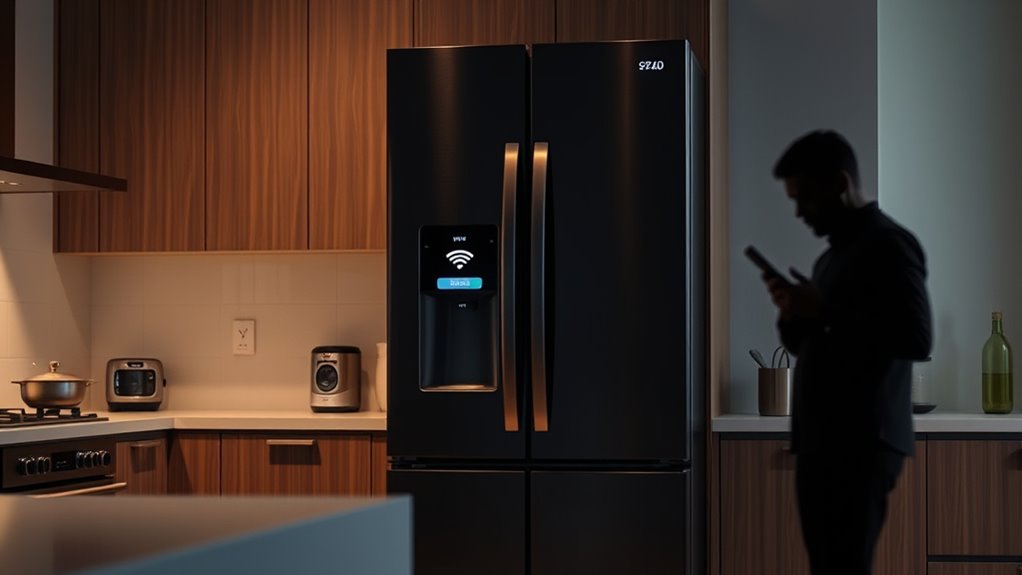
To effectively protect your smart home, start by securing your Wi-Fi network with a strong, unique password and enabling encryption protocols like WPA3. This prevents unauthorized access to your connected devices. Set up separate user profiles for family members to control access levels, ensuring sensitive data stays protected. When using voice commands, be cautious about what information you share aloud, as some devices may record and store these interactions. Regularly update your device firmware to patch security vulnerabilities. Disable features you don’t use, such as remote access or voice activation, if they aren’t necessary. Additionally, exploring crochet styles for locs can be a creative way to personalize your look while maintaining a protective hairstyle. By taking these steps, you reduce the risk of privacy breaches and keep your smart appliances—and your personal data—safe from prying eyes.
Future Trends and Privacy Considerations

As smart appliances become more integrated into everyday life, their future development promises even greater convenience and functionality. Voice recognition will likely become more sophisticated, allowing your devices to respond accurately to natural speech and understand your preferences better. AI personalization will enable appliances to adapt to your routines, optimizing energy use and suggesting tailored adjustments. Additionally, these devices may incorporate exotic fruit blends or other customized settings to enhance user experience. However, these advancements raise important privacy considerations. As your appliances collect more data, the risk of unauthorized access or misuse increases. You’ll need to stay vigilant about data security and privacy policies. Manufacturers might implement stronger encryption and transparent data practices, but it’s essential for you to remain informed. Balancing innovation with privacy protection will be essential as connected appliances continue to evolve.
Frequently Asked Questions
Can Smart Fridges Detect and Record My Personal Conversations?
You wonder if your smart fridge can detect and record your personal conversations. While it might use voice recognition to help manage functions, most don’t actively monitor conversations. However, connected appliances could inadvertently capture snippets of dialogue if voice commands are mistakenly triggered. Stay cautious—these devices are designed for convenience, but their sensors might pick up more than you realize, raising questions about privacy and conversation monitoring.
Who Has Access to the Data Collected by Connected Appliances?
You might wonder who has access to your data from connected appliances. Typically, the device manufacturer or service provider owns the user data, but your data ownership rights vary by terms of service. They can access, store, and sometimes share your data with third parties for analytics or marketing. To protect your privacy, review the privacy policies, limit data sharing, and adjust security settings whenever possible.
Are There Legal Protections Against Privacy Invasions by Smart Devices?
Did you know that over 80% of consumers worry about their privacy with smart devices? Privacy laws and consumer protections aim to guard your data, but they often lag behind rapidly evolving technology. While laws like GDPR and CCPA set standards, enforcement can be inconsistent. You should stay informed and exercise control over your device settings, as legal protections are crucial but not foolproof against privacy invasions.
How Often Are Firmware Updates Released to Fix Security Flaws?
Firmware update frequency varies depending on the device and manufacturer. Typically, companies release firmware patches regularly, often every few months, to fix security flaws and improve functionality. However, some brands may update less frequently or require user prompts to install updates. To stay protected, you should check your connected appliances often, enable automatic updates when available, and stay informed about firmware patches to guarantee your device remains secure.
Can I Completely Disconnect My Smart Appliance From the Internet?
Yes, you can disconnect your smart appliance from the internet. To do so, you might need to disable Wi-Fi or unplug it directly. Keep in mind, doing this limits data encryption and user authentication, which are crucial for security. While disconnecting offers more privacy, it also reduces functionality. Consider balancing convenience with security by regularly updating firmware and reviewing your device’s privacy settings.
Conclusion
As you embrace the convenience of connected appliances, it’s wise to stay aware of the subtle ways your privacy may be gently intertwined with technology. By taking simple precautions, you can enjoy the benefits without unwittingly opening doors to unwanted attention. Remember, a little vigilance now can keep your smart home a secure sanctuary—letting you savor the modern comforts while quietly safeguarding your personal space from unseen eyes.
